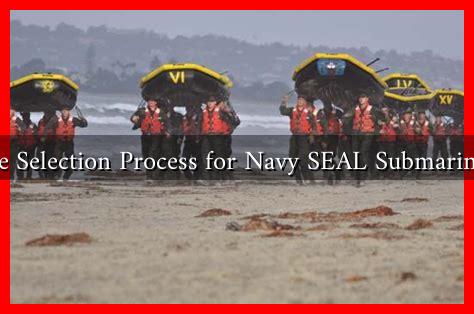-
Table of Contents
- What Is the Selection Process for Navy SEAL Submarine Training?
- Understanding the Role of Navy SEALs in Submarine Operations
- Eligibility Criteria for Navy SEAL Candidates
- The Selection Process: From Basic Training to SEAL Qualification Training
- 1. Basic Underwater Demolition/SEAL (BUD/S) Training
- 2. SEAL Qualification Training (SQT)
- Specialized Submarine Training
- Challenges and Considerations
- Conclusion
What Is the Selection Process for Navy SEAL Submarine Training?
The Navy SEALs are among the most elite special operations forces in the world, known for their rigorous training and exceptional capabilities. One of the unique aspects of their training is the integration of submarine operations, which requires a specialized selection process. This article delves into the selection process for Navy SEAL submarine training, highlighting the requirements, stages, and challenges involved.
Understanding the Role of Navy SEALs in Submarine Operations
Navy SEALs are tasked with a variety of missions, including direct action, reconnaissance, and counter-terrorism.
. Submarine operations are crucial for stealthy insertions and extractions, allowing SEALs to operate undetected in hostile environments. The integration of submarine training enhances their operational capabilities, making them versatile in various combat scenarios.
Eligibility Criteria for Navy SEAL Candidates
Before candidates can even think about submarine training, they must first meet the basic eligibility criteria to become a Navy SEAL. These include:
- U.S. citizenship
- Age between 17 and 28 years (waivers available up to 30)
- High school diploma or equivalent
- Passing the Armed Services Vocational Aptitude Battery (ASVAB) test
- Meeting physical fitness standards
Once these criteria are met, candidates can begin the selection process, which is divided into several stages.
The Selection Process: From Basic Training to SEAL Qualification Training
The journey to becoming a Navy SEAL and qualifying for submarine training is arduous and demanding. Here’s a breakdown of the selection process:
1. Basic Underwater Demolition/SEAL (BUD/S) Training
BUD/S is the initial training phase for all SEAL candidates. It lasts approximately six months and is divided into three phases:
- Phase 1: Physical conditioning, including running, swimming, and obstacle courses.
- Phase 2: Diving, focusing on underwater skills and techniques.
- Phase 3: Land warfare, which includes small unit tactics and navigation.
Only a fraction of candidates who start BUD/S will complete it, with attrition rates often exceeding 70%. This phase is designed to test physical endurance, mental toughness, and teamwork.
2. SEAL Qualification Training (SQT)
After successfully completing BUD/S, candidates enter SQT, which lasts about 26 weeks. This phase includes advanced training in various areas:
- Weapons handling and marksmanship
- Close-quarters combat
- Survival, evasion, resistance, and escape (SERE)
- Advanced diving techniques
Upon completion of SQT, candidates earn the SEAL Trident, signifying their qualification as Navy SEALs.
Specialized Submarine Training
Once candidates have qualified as SEALs, they can apply for submarine training. This specialized training focuses on the unique skills required for underwater operations. Key components include:
- Submarine escape training
- Advanced diving and underwater navigation
- Operational procedures for covert insertions and extractions
Training often takes place at facilities such as the Naval Special Warfare Center in Coronado, California, and includes simulations and real-world exercises.
Challenges and Considerations
The selection process for Navy SEAL submarine training is not just about physical prowess; it also requires mental resilience and adaptability. Candidates must be prepared for:
- High-stress environments
- Team dynamics and leadership challenges
- Extended periods of isolation during submarine missions
Statistics show that only a small percentage of those who begin the process will complete it successfully, underscoring the elite nature of the training.
Conclusion
The selection process for Navy SEAL submarine training is a rigorous journey that tests candidates’ physical, mental, and emotional limits. From BUD/S to SQT and specialized submarine training, each stage is designed to ensure that only the most capable individuals become part of this elite force. The integration of submarine operations into SEAL training not only enhances their capabilities but also prepares them for the complexities of modern warfare. For those who aspire to join the ranks of the Navy SEALs, understanding this selection process is crucial for success.
For more information on Navy SEAL training and operations, you can visit the official Navy SEALs website.





